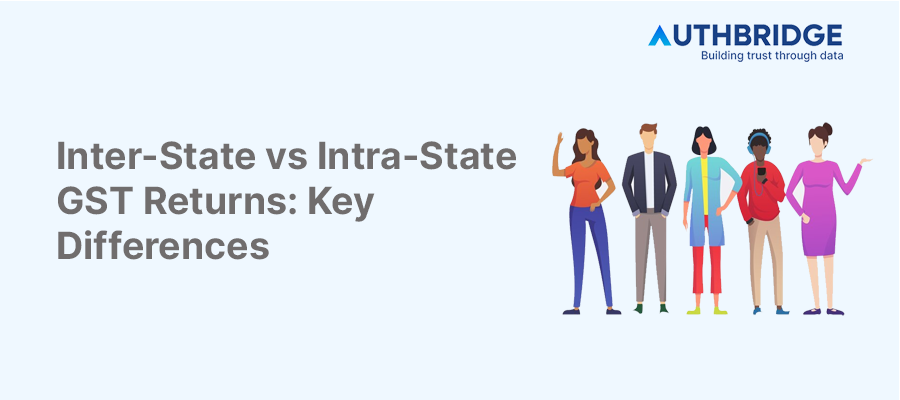Inter-State Vs Intra-State GST Returns: Understanding Key Differences And Compliance Strategies

Concept and Basis of Classification
The Goods and Services Tax (GST) in India revolutionized the indirect tax landscape by amalgamating several older taxes into a single tax system. This system distinguishes between inter-state and intra-state transactions based on the location of the supplier and the place of supply. Understanding this distinction is crucial for businesses to apply the correct GST rates, ensure compliance, and optimize their Input Tax Credit (ITC).
- Inter-state transactions (IGST) involve the movement of goods or provision of services across state or union territory boundaries.
- Intra-state transactions (CGST and SGST/UTGST) occur when both the supplier and the place of supply are in the same state or union territory.
Detailed Analysis of GST Types
Inter-State GST (IGST)
- Applicability: IGST is levied on all transactions that cross state lines, including exports and imports, and transactions with Special Economic Zones (SEZs).
- Tax Collection and Apportionment: The central government collects IGST and then apportions it between the states involved. This ensures that the consuming state receives its share of tax revenue, adhering to the destination principle of GST.
Example: A supplier in Maharashtra sells goods to a customer in Tamil Nadu. IGST is applicable, and the revenue is shared between Maharashtra and Tamil Nadu.
Intra-State GST (CGST and SGST/UTGST)
- Understanding the Components: CGST (Central GST) and SGST (State GST) are levied on intra-state supplies. UTGST replaces SGST in union territories without legislatures.
- Revenue Sharing: CGST revenue goes to the central government, while SGST/UTGST revenue stays with the state/union territory.
Example: A service provided in Karnataka to a customer also in Karnataka attracts both CGST and SGST.
Key Differences and Their Impact on Businesses
Feature | IGST | CGST + SGST/UTGST |
Jurisdiction | Across states/UTs | Within the same state/UT |
Collected By | Central Government | Central and State Governments |
Revenue Sharing | Between consuming and supplying states | Between Central and State Governments of the same state |
Input Tax Credit (ITC) Utilization Across GST Types
The mechanism for utilizing ITC varies significantly between inter-state and intra-state transactions. This system ensures that taxes paid during purchases can be offset against the liability on sales, effectively ensuring that tax is paid only on the value added.
- IGST Paid on inter-state purchases can be utilized to offset IGST, CGST, and SGST liabilities in that order.
- CGST and SGST Paid cannot be used to offset each other but can be utilized against IGST liabilities.
Filing GST Returns: Navigating Inter-State and Intra-State Transactions
Businesses must accurately report their inter-state and intra-state transactions in their GST returns. This includes detailing supplies made, ITC claimed, and taxes paid. Proper classification ensures compliance and maximizes ITC utilization.
- GSTR-1: Reports outward supplies, distinguishing between inter-state and intra-state sales.
- GSTR-2A/2B: Auto-populated returns showing inward supplies, crucial for ITC claims.
- GSTR-3B: Summarizes tax liabilities and ITC claimed, requiring careful distinction between IGST, CGST, and SGST/UTGST.
Addressing Common Challenges
Businesses often face challenges in distinguishing between inter-state and intra-state transactions, especially in complex supply chains or when services are delivered digitally. Regular training, robust accounting software, and consultation with GST experts can help navigate these challenges.
Conclusion: Embracing Compliance and Optimization
Understanding the nuances of inter-state and intra-state GST transactions is not just about compliance; it's about leveraging the GST framework for business optimization. Accurate classification, timely return filing, and effective ITC utilization are pillars of a successful GST strategy.
Businesses are encouraged to invest in GST-compliant software solutions, stay updated on GST regulations, and engage with professionals for advisory services. This proactive approach not only ensures compliance but also positions businesses for growth and efficiency in the GST era.
Category

Abhinandan Banerjee
(Associate Manager - Marketing)
Abhinandan is a dynamic Product and Content Marketer, boasting over seven years of experience in crafting impactful marketing strategies across diverse environments. Known for his strategic insights, he propels digital growth and boosts brand visibility by transforming complex ideas into compelling content that inspires action.



